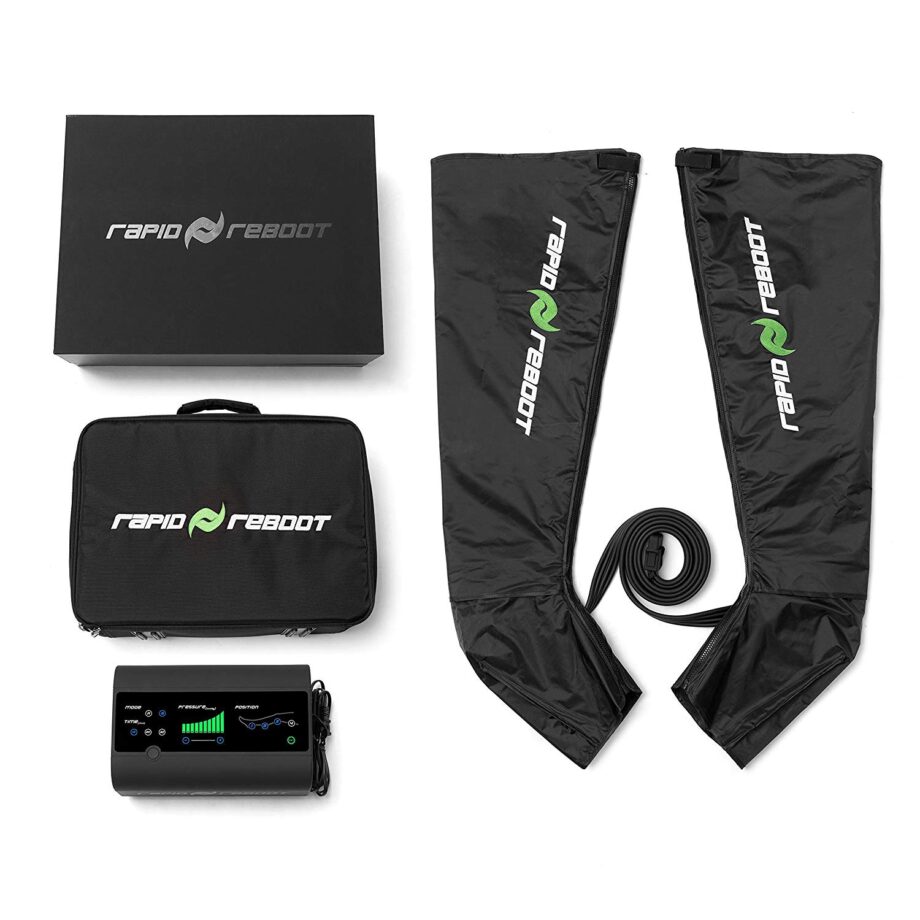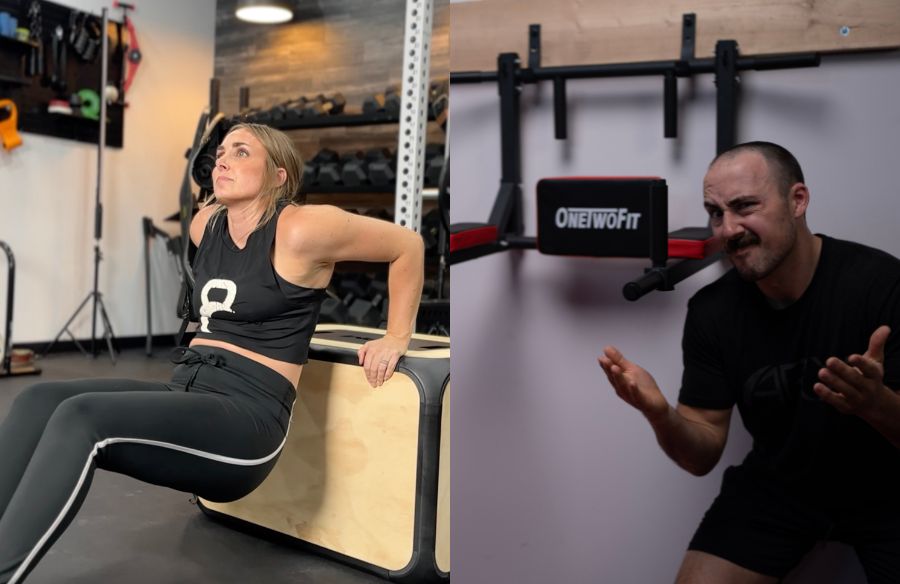The Rapid Reboot Recovery System is a great option for anyone looking for an advanced recovery system. By offering two different modes of compression, ability to adjust the pressure of each compression, and multiple time options, the Rapid Reboot System is one of the best compression boot systems on the market today.
Rapid Reboot
Rapid Reboot Recovery System

Product Highlights
-
Used by athletes of all levels
-
Supports circulation and recovery
-
Durable construction
Pros & Cons
Bottom Line
Rapid Reboot Recovery System Review

Compression therapy is nothing new in the recovery world. Companies have been using compression as a means to increase athlete performance by a number of different methods. These methods include compression garments, compression socks, compression boots, and others.
Recovery is typically divided into to two different categories, active and passive recovery. In fitness communities such as CrossFit, active recovery is a very popular form of recovery.
What this can entail is performing a workout of the day at 60-70% percent of your normal output. For the untrained, active recovery can mean walking the dog, playing catch, or going on a hike.
Passive recovery involves doing almost nothing. Laying down, take a nap, etc. This form of recovery should probably only be exercised in cases that include certain types of injuries.
The goal of active recovery is allowing your body to flush out metabolic waste and allow new blood flow to the affected areas.

The Rapid Reboot Recovery System uses the concept of active recovery through a passive recovery posture. These recovery boots use the process of Peristaltic Pulse Dynamic Compression to allow your body to increase venous return and maintain a natural approach to flush out metabolic waste.
The Rapid Reboot Recovery System is broken up into two different modes, Mode A and Mode B. Both of these modes compress and decompress the four different zones, however, one of the modes does not have a full boot compression at any point in the process.
The Reboot is broken up into four different zones. The first zone is the foot, the second zone is the calf, the third zone is the kneecap area, and the fourth zone focuses on the quadriceps/hamstrings.
If Mode A is chosen, this is what Rapid Reboot System refers to as their Peristaltic mode. Peristaltic refers to successive waves of involuntary contraction passing along the walls of a hollow muscular structure and forcing contents onward.

How this translates to the Reboot System is, while a zone is compressing, every other zone is decompressed.
For example, all compressing begins in zone 1, or the foot area, from there, zone 2 becomes compressed. Once compressing begins in zone 2, zone 1 becomes decompressed. This formula continues throughout the entire cycle.

The cycle will end with the result of zone 4 going from compression to decompression, and starting over with the compression of zone 1.
If Mode B is chosen, each zone of the Rapid Reboot System will be compressed at some point during the cycle. This is what Rapid Reboot calls their recovery mode.

The Reboot System always begins compressing in zone 1, from there, the compressions continue to zone 2, 3, and 4. While the compressions are moving up the leg, the previous zones maintain compressed.
For example, if the Reboot System is currently compressing the 3rd zone, zones 1 and 2 and still fully compressed. The Reboot System completely decompresses at the end of the cycle, which would be after zone 4. Once the cycle ends, it begins again with zone 1. Constantly moving from bottom to top (zone 1-4).

A great feature of the Rapid Reboot Recovery System is the ability to adjust the pressure of the compression.
The pressure of the Reboot system is measured in mmHg which is an abbreviation for millimeters of mercury. The pressure can be a maximum of 200 mmHg while the lowest compression pressure is 20 mmHg.
The default pressure is at the maximum 200 mmHg, if you experience any sort of pain, simply press the decrease icon on the console. Likewise, if the pressure is not enough, simply press the plus icon to increase the pressure.

Overall, it does not take a maximum effort of 200 mmHg to get a quality compression, so you can start low and move to a comfortable experience. The Reboot System is not designed to cause pain or be uncomfortable.
Not only is the Rapid Reboot System able to have variance in pressure, the Reboot System also allows a user to change the amount of time of rebooting.
There are three different time variances, 10, 20, and 30 minutes. The Reboot Recovery system allows you to choose the exact recovery you need.

If recovering from a long workout, it is common to have the cycle run for either 20 or 30 minutes. If all you need is a quick recovery or warm up, 10 minutes is plenty to have fresh venous return.
Another feature of the Rapid Reboot System is the ability to choose which zone is compressing.
For example, if zone 3 is compressing, the number “3” under the POSITION setting will be blinking to indicate that is the current zone being compressed. To deactivate any zone from compressing, simply pause the cycle. To pause the cycle, press the START button, once the pump is paused, simply click the desired zone that you do not want to compress, and press START again to resume.
The control pump of the Rapid Reboot Recovery System has two connections, one for power, and the other connection is a single plug-in that turns into a double power source and attaches to the boots separately.
Rapid Reboot also offers their boots in multiple sizes to accommodate more people.

For people 5 feet and under, size XS is recommended. 5′ 1″-5′ 3″ should fit into a size S. People from the height of 5’3″-5’10” should order size M. 5’10”-6’3″ will likely fit into L, and finally people that should order an XL should be 6’3″ and above.
Multiple studies have been conducted on the correlation between recovery andPeristaltic Pulse Dynamic Compression system.
Between nine different studies, six of those studies had a positive correlation in favor of compression systems, while three studies showed no correlation. The reason that all nine studies did not have a positive correlation was due to the type of workouts.

Positive results were found in the following articles:
- Enhance of Tibialis Anterior Recovery by Intermittent Sequential Pneumatic Compression of Legs
- The Effects of the Modified Intermittent Sequential Pneumatic Device on Exercise Performance Following an Exhaustive Exercise Bout
- Intermittent Pneumatic Compression Technology for Sports Recovery
- Intermittent Pneumatic Compression Effect on Eccentric Exercise-Induced Swelling, Stiffness, and Strength Loss
- The Effect of Intermittent Sequential Pneumatic Compression on Recovery Between Exercise bouts in Well-Trained Triathletes
- Effects of intermittent pneumatic compression vs. neuromuscular electrical stimulation on recovery following anaerobic exercise in male basketball players
No findings in the correlation between recovery and compression systems were found in the following articles:
- Does intermittent pneumatic leg compression enhance muscle recovery after strenuous eccentric exercise?
- Acute Effects of Peristaltic Pulse Dynamic Compression on Recovery: Kinetic, Kinematic, and Perceptual Factors
- Acute Effects of Peristaltic Pneumatic Compression on Repeated Anaerobic Exercise Performance and Blood Lactate Clearance
Throughout our research, we began to notice a trend in the testimonies that declared a positive result in dynamic compression devices like Rapid Recovery Boots. These testimonies had a common factor of the type of workout that was taking place.

In almost all of the positive results in favor of recovery boots, the exercises that were performed were either short burst anaerobic exercising or endurance training.
For example, people that perform long periods of biking, cycling until exhaustion, triathalons, and sprint training will typically experience the best result of the recovery boots. The reason that recovery boots work well for these types of workouts is the ability of the recovery boots have to break down the lactic acid build up.
Workouts that did not have a positive effect with the recovery boots were eccentric workouts.

Eccentric workouts are the bodybuilding exercises that are strength training and muscle-damaging. The reason for this is, eccentric exercises have a lot of inflammation that takes place as a result of a workout rather than lactic acid build up. Recovery boots are able to break down lactic acid, but not repair inflammation.
With that being said, my workouts consist of strength training exercises and I use the recovery boots often the following day of leg day. I typically feel much better after using the recovery boots and I would recommend them to people who strength train.

Rapid Reboot also offers their customers a 2-year warranty on everything for their product. When ordered, the entire recovery system comes in a padded carrying case for travel which is an awesome touch.
Overall, the Rapid Reboot Recovery System is a great option for anyone looking for an advanced recovery tool. By offering two different modes of compression, ability to adjust the pressure of each compression, and multiple time options, the Rapid Reboot System is one of the best compression boot system on the market today.
Suggested Improvements
The Rapid Reboot Recovery System is a great system for anyone looking for a new recovery method, however, there are a couple of things that would make it an even better product.
The first thing would be adding another zone. A competitor to the Rapid Reboot Recovery System is the Normatec that uses recovery boots as well. Their system has five zones compared to Reboots four. Adding another zone would add another sector of compression for the person recovering.
The second thing I would suggest is making the console smaller. The Rapid Reboot console is very big but effective. It would be great to make it smaller for traveling, or even the ability to control it with an app.
Full Rating
Rapid Reboot Recovery System

The Rapid Reboot Recovery System is a great option for anyone looking for an advanced recovery system. By offering two different modes of compression, ability to adjust the pressure of each compression, and multiple time options, the Rapid Reboot System is one of the best compression boot systems on the market today.
Product Brand: Rapid Reboot
Product Currency: $
Product Price: 995
Product In-Stock: InStock
4.6
Where to Purchase
Rapid Reboot
Rapid Reboot Recovery System

Product Highlights
-
Used by athletes of all levels
-
Supports circulation and recovery
-
Durable construction
Pros & Cons
Bottom Line
Rapid Reboot Recovery System FAQs
What does rapid reboot do?
Rapid Reboot compression technique facilitates cellular repair and protein synthesis by increasing blood flow to your muscles, increasing lymphatic drainage to decrease inflammation and minimize edema, and moving waste products such as lactic acid and excess fluids.
When should I use Rapid Reboot?
Rapid Reboot is perfect for immediately following an exercise, race, or event, especially if it was a long and strenuous one. The boots, on the other hand, may be worn after a long run, if your legs are sore, or whenever you feel the need to recharge.
What is rapid boot?
Classic Pump and Compression Boots Every Athlete Benefits from Sequential, Dynamic Air Compression for Massage Therapy, Improved Circulation, and Faster Recovery







